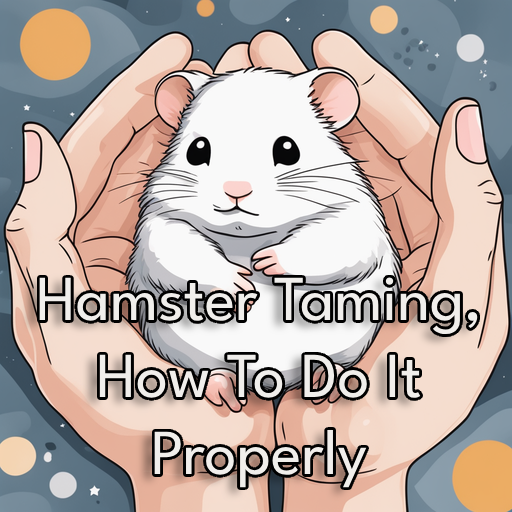Hamster taming is a rewarding journey that strengthens the bond between you and your furry friend. Hamsters are naturally cautious creatures, but with patience and the right approach, you can build trust and turn your skittish pet into an affectionate companion. In this guide, we’ll explore the art of taming your hamster, providing you with practical tips and advice to make the process smooth and stress-free.
The benefits of Hamster taming
Before we delve into the how-to of hamster taming, it’s essential to understand the reasons why this process is beneficial. Taming your hamster offers several advantages that contribute to a healthier, happier, and more enriching relationship with your pet:
Strengthens the Bond:
Taming is a crucial step in building a strong bond with your hamster. When you dedicate time and effort to taming, your hamster becomes familiar with your scent, voice, and touch. Over time, this familiarity fosters trust and a strong connection between you and your pet. This bond not only enhances your hamster’s quality of life but also makes the relationship more rewarding for you as a pet owner.
Reduces Stress:
The Benefits of Hamster Taming
Before we delve into the how-to of hamster taming, it’s essential to understand the reasons why this process is beneficial. Taming your hamster offers several advantages that contribute to a healthier, happier, and more enriching relationship with your pet:
1. Strengthens the Bond:
Taming is a crucial step in building a strong bond with your hamster. When you dedicate time and effort to taming, your hamster becomes familiar with your scent, voice, and touch. Over time, this familiarity fosters trust and a strong connection between you and your pet. This bond not only enhances your hamster’s quality of life but also makes the relationship more rewarding for you as a pet owner.
2. Reduces Stress:
A tamed hamster is less stressed when interacting with you. The process of taming involves gradual and gentle exposure to human interaction, which reduces fear and anxiety in your hamster. When your pet is less stressed, it leads to a healthier and happier hamster. Stress in hamsters can manifest in various ways, such as decreased activity, overgrooming, or even aggression. Taming helps alleviate these stress-related behaviors, providing your hamster with a more relaxed and contented life.
3. Enables Handling:
Tamed hamsters are more comfortable with being held and gently handled. This makes essential tasks like cage cleaning, health checks, and grooming much more manageable. When your hamster is accustomed to human touch, it becomes easier to provide the care they need without causing them distress or discomfort. Handling your hamster is essential for maintaining their health, cleanliness, and overall well-being.
Supplies You’ll Need for Hamster Taming
Before starting the taming process, gather the following supplies:
- Treats: High-quality treats such as small pieces of fresh vegetables or fruits (just keep away from citrus ones).
- Quiet Space: Choose a quiet, calm room where you can interact with your hamster without disruptions.
- Hands-Off: Wash your hands thoroughly and use fragrance-free soap to eliminate any strong scents that may startle your hamster.
- Gloves: These are optional, however if your hamster tends to bite, gloves are helpful from the start until your pet gets used to you. We like these soft gloves and they have plenty of good reviews

- Taming Tools: A wooden bridge or a small, flat bridge-like structure for the hamster to walk across during taming sessions. The stable one
How long does it take to tame your hamster?
The time it takes to tame a hamster can vary widely from one hamster to another. Some hamsters become comfortable and tame relatively quickly, while others may take more time and patience. On average, it may take several weeks to a few months to fully tame a hamster.
The taming process involves building trust between you and your hamster, and it typically progresses through steps. Here are the steps in hamster taming and a rough estimate of the time it might take for each.
The Step-by-Step Taming Process
Step 1: Start Slow
The first few days or weeks may be focused on your hamster becoming accustomed to your presence, scent, and voice. Begin by spending time near your hamster’s cage, talking to them in a soft and gentle tone. Place treats near their cage but not inside it. This helps your hamster associate your presence with positive experiences. You can use toys to relax them like this cute little climbing bridge.
Step 2: Hand Feeding
Hand-feeding treats typically begin after the initial trust-building phase. This step may take a few days to a few weeks, depending on your hamster’s comfort level. Once your hamster seems comfortable with your presence, start hand-feeding treats. Extend your open hand, offering a treat on your palm. Let your hamster approach and take it at their own pace. Repeat this process daily.
Step 3: Allow Exploration
When your hamster becomes confident taking treats from your hand, try gently stroking their back or head while they eat. If they seem uncomfortable, go back to just hand-feeding for a few days. Continue the gentle petting when they’re ready.
Step 4: Lift and Hold
Once your hamster tolerates being gently petted, you can gradually introduce lifting. Cup your hand under your hamster and lift them gently, supporting their body. Keep this time short at first, and over days or weeks, gradually extend it.
Step 5: Taming Sessions
Achieving a fully tamed hamster can take several weeks to a few months. Full taming means your hamster is comfortable with being held, petted, and handled without stress or fear. Designate specific taming sessions, around 10-15 minutes, where you interact with your hamster. Keep these consistent and increase the duration as your hamster becomes more comfortable.
Step 6: Be Patient
Remember that the taming process varies from hamster to hamster. Some may become confident quickly, while others may take more time. Always be patient and gentle, ensuring that every interaction is a positive one.
Common Taming Challenges

Biting:
In the early stages, some hamsters may nip out of fear or uncertainty. If this happens, don’t react strongly. Gently put your hamster back and try again later. The nipping often diminishes as trust builds.
Signs of Stress:
Keep an eye out for stress signs like rapid breathing, hissing, or flinching. If you see these, back off and try again in a more gradual manner.
Conclusion
Taming your hamster is a rewarding experience that deepens the bond between you and your furry friend. Remember, patience and gentleness are the keys to success in this process. By following the steps outlined in this guide, you’ll soon have a well-tamed hamster as your companion.
If you need quick tips on Hamster care for beginners, we’ve got you covered in this article 😊









